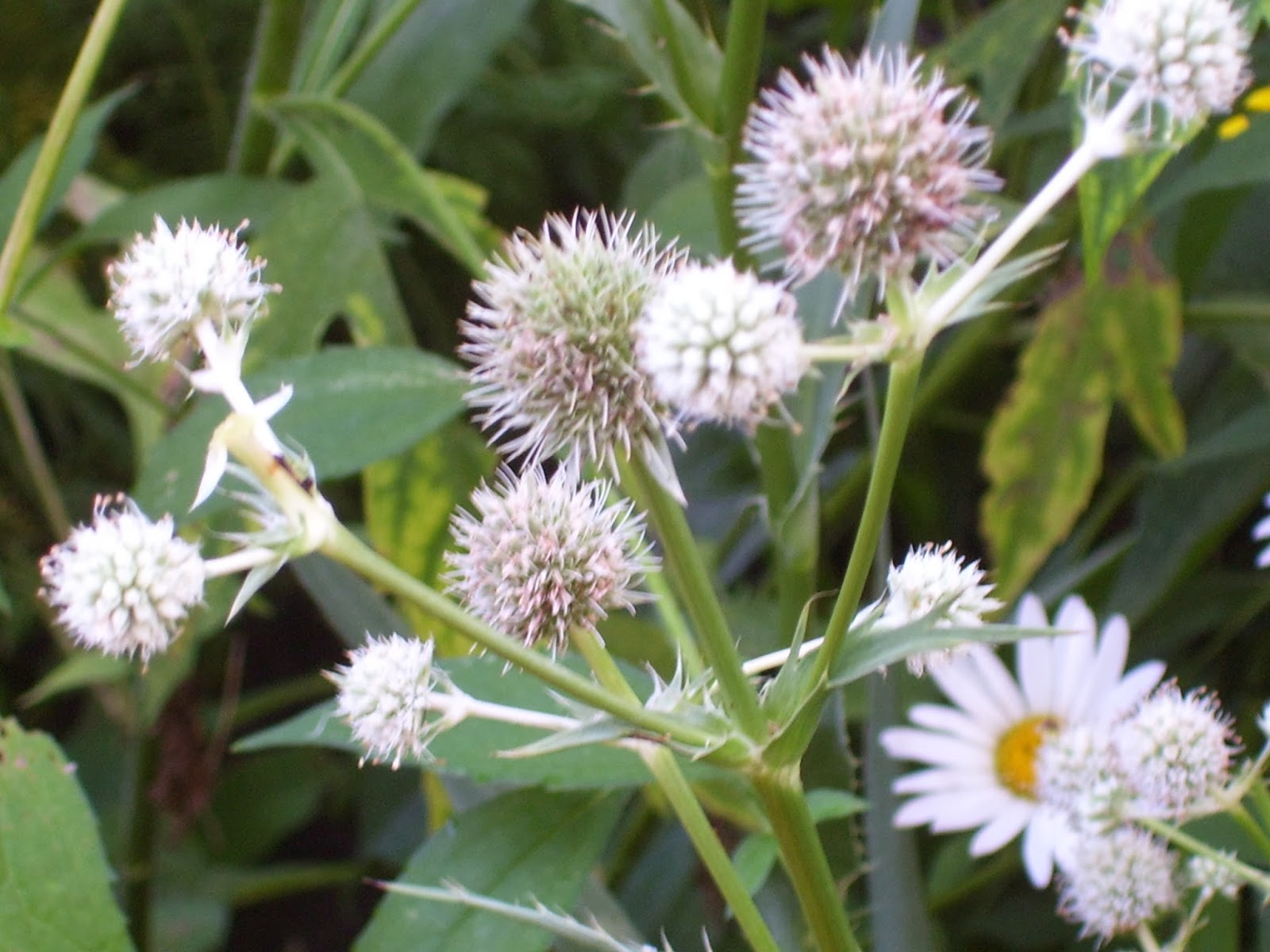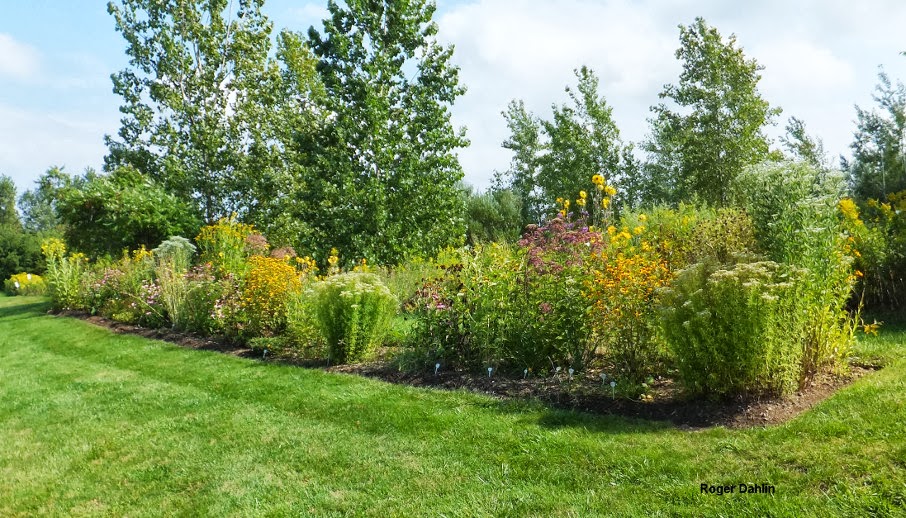Inviting Syrphid Flies for Lunch!
 |
| Syrphrid Fly - Hover Fly |
How to best deal with Milkweed Aphids (Oleander aphids) which have a preference for Asclepias species (milkweed) has created a bit of a dilemma for sometime now.
As an aspiring organic farmer, applying pesticides is out of the question, besides it doesn’t make sense to raise native plants only to exterminate insects one attracts. In addition, there is risk of accidentally damaging butterfly eggs and larvae.
As an aspiring organic farmer, applying pesticides is out of the question, besides it doesn’t make sense to raise native plants only to exterminate insects one attracts. In addition, there is risk of accidentally damaging butterfly eggs and larvae.
In the past, I devised a strategy
which temporally outwitted those six legged beady-eyed, mustard colored aphids; I sold milkweed plants early in
the season, before they flowered. This provided a reasonable solution as
typically aphids infest our plants late in the summer. It quickly became apparent that
customers preferred purchasing plants in bloom, especially ones they were not
familiar with. Another possible course of action was to wipe down each
plant. Not only does that mask the problem, I honestly don’t have the time or
patience for it.
The reality is, once Asclepias
plants have been purchased and planted, there is a fairly good chance local
aphids will discover them! Other articles suggest using a powerful spray to
blast them out of the universe. From my experience, yes they are sent flying but
only to return a bit soggy and bedraggled the next day.
 |
| Butterfly Weed - Asclepias tuberosa |
In 2013 at NOG our aphid population
was noticeably less than the previous year, even though our milkweed inventory
had doubled. I considered the fact that the hot dry summer may have played a
role. My hunch was correct. According to author H.J.McAuslane, at the University of Florida, decreasing water and
fertilizer levels tends to reduce milkweed aphid populations.
Douglas Tallamy, in his book "Bringing Nature Home" confirms this, explaining second generation winged aphids forge for nitrogen, found in phloem of asclepias stems.
Douglas Tallamy, in his book "Bringing Nature Home" confirms this, explaining second generation winged aphids forge for nitrogen, found in phloem of asclepias stems.
 |
| Milkweed Aphids |
Is it then possible to provide a less desirable gourmet feast without sacrificing the health and quality of our plants? Perhaps, if our entrees were a bit less palatable, Oleanders would head towards I 90 with thumbs held high!
“What are Natural Predators of Oleander Aphids?”
 |
| Gray-headed Coneflower |
Managing water and fertilizer levels is easier said than done. I am bit concerned, that decreasing sugar levels may have an adverse effect on roots surviving harsh Ohio winters?
I decide to approach this from a different direction, “What
are the natural predators of the Oleander Aphids?” Fortunately, this question was answered in a thread on the website What's That Bug?
As it turns out I was correct in
assuming that hosing down aphids doesn’t eradicate the problem, as a
matter of
fact a powerful spray actually drowns natural predators like the larvae
of the
Lacewing and Syrphid Fly (Hover Flies).
For the sake of time and length
of the
post, I decide to concentrate on discovering how to attract Hover Flies.
Hover
flies do indeed hover like helicopters; flying both forward and
backwards, maybe inside out and upside down. They resemble bees but have only one set of wings not two,
are less harry and actually do have beady little eyes. Larvae are
especially ravenous, consuming up to 400 aphids during their growth
period. Now these guys you want to invite to lunch!
“What Native Plants Attract Syrphrid Flies?”
 |
| Golden Alexander - Apiaceace Family |
“You
can attract Syrphid Flies with blossoms, especially those in the composite
family Asteraceae and umbel blossoms in the families Apiaceae and
Alliaceae. We always let some of our carrots and onions go to blossom because
of the beneficial insects they attract."
Asteraceae (Aster) Family includes a large number of plants like: Joe-Pye-Weed, Downy Sunflowers, Purple Coneflower, New York
Ironweed and Purple-headed Sneezeweed. We raise only two native plants in the Apiaceae (carrot) Family:
Golden Alexander and Rattle Snakemaster and one in the Alliaceae (Onion) Family,
Nodding Onion (Allium cernuum). However, the USDA Department of Natural
Resources list Nodding Onion as being in the Liliaceae family.
Regardless of how Nodding Onion is categorized
it is apparent we have room for improvement when it comes to raising a more diverse
group of native plants.
Regardless of how Nodding Onion is categorized it is apparent we have room for improvement when it comes to raising a more diverse group of native plants.
In Heather Holm's new book, Pollinators of Native Plants,
Attract, Observe, and Identify Pollinators and Beneficial Insects with
Native Plants. Holms mentions: Swamp
Marigold (Ranunculaceae Family), Ohio Spiderwort (Commelinaceae Family,)
Purple Prairie Clover ( Fabaceae Family) and numerous other native plants
as attracting Syrphid flies to consume pollen, nectar, or both. How
exciting! The list of native plants which one can expect to “lure” in Hover
Flies includes more plants than I expected!
A Few of our Native Plants That Attract Syrphid Flies
 |
| Brown-eyed Susans - Asteraceae Family |
 |
| Rattle Snakemaster - Apiaceace Family |
 |
| Cup Plant - Asteraceae Family |
 |
| Purple Coneflower - Asteraceae Family |
 |
| New York Ironweed - Asteraceae Family |
Strive for Diversity
It really isn't important if you plant 5 native plants in family "A" or six in family "B" what really matters is diversity/variety. Experiment! Try growing one or two new native plant species each year. Consider raising them from seed, although a bit more work it is extremely rewarding. Grow your favorite annuals, herbs and vegetables, they too attract native pollinators.
Make a point to familiarize yourself with your region's non-native, invasive species. What resource zappers they are, taking more than their share of: water, garden space and soil nutrients. Chance are, Hover Flies won't even give them a second glance!
The Tricky Part is Stepping Back and Letting the "Picnic" Begin!
References
Books
Holm, Heather. Pollinators of Native Plants Attrqact, Observe and Identify, Pollinatorsa and Benificial Insects with Native Plants. Portland, Or.: Timber, 2007. Print.
Mader, Eric. Attracting Native Pollinators: Protecting North America's Bees and Butterflies: The Xerces Society Guide. North Adams, MA: Storey Pub., 2011. Print.
Tallamy, Douglas W. Bringing Nature Home: How Native Plants Sustain Wildlife in Our Gardens. Portland, Or.: Timber, 2007. Print.Bartlett,
Websites
Bartlett, Troy."Family Syrphidae - Syrphid Flies". Bug Guide. Iowa State University Entomology. 16 February, 2004
Bugg,Robert.""Flower Flies (Syrphidae) andOther Biological Control Agents for Aphids in Vegetable Crops".
University of California Division of Agriculture and Natural Resources, Publication 828, May 2008
"Flower Flies (Syrphidae) and Other Biological Control Agents for Aphids in Vegetable Crops" N.p., n.d. Web. 02 Mar. 2014.
Marlos, Daniel. "Syrphid Fly Larvae eat Oleander Aphids on Milkweed." What's That Bug?. 9 Sept., 2013.
"Oleander Aphid - Aphis Nerii Boyer De Fonscolombe." Oleander Aphid - Aphis Nerii Boyer De Fonscolombe.
"Phloem vs Xylem." - Difference and Comparison.
Reveal, James. "YYPG by Family". Plant Systmatics.org, Department of Plant Biology Cornell University. 24 May 2013
Saupe, Stephen. "Solute Transport: "Phloem Structure & Function." Home Page
- Stephen G. Saupe. College of St. Benedict/St. John's University,Collegeville, MN, Jan. 7, 2009. Mar. 2, 2014.



Excellent post! I know where some of my Ironweed will be planted! On my list of perennials to get this year is New England Asters and I already have Brown Eyed Susans, so I feel better already about those little buggers!
ReplyDelete
ReplyDeleteBeth, You have such a wide range of flowers and vegetables growing in your yard (in summer) I would be surprised if you have a problem with aphids. It will be fun to watch and see what happens!
Both the milkweed and aphids are keystone species, providing forage and prey for many other insects. I have seen lots of flower flies on umbellifers, including cilantro/coriander, parsley, and Queen Anne's Lace.
ReplyDeleteThank you Pam, What a bonus with the parsley and cilantro, they attract natural predators and you can use them in the kitchen!
ReplyDeleteHeya i am for the first time here. I found this board and I find It really useful & it helped me
ReplyDeleteout much. I hope to give something back and aid others like you helped me.